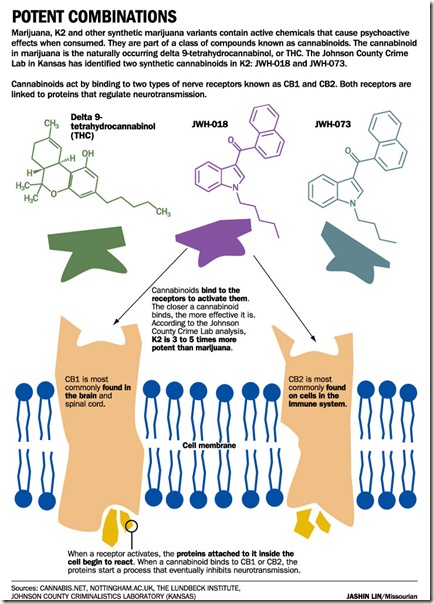magickpencil
Alpiniste Kundalini
- Inscrit
- 15/5/08
- Messages
- 674

A legal substance that mimics the effects of marijuana is responsible for some hospitalizations across the country but has not proven to be a significant presence in mid-Missouri.
K2, a substance that state Sen. Kurt Schaefer, R-Columbia, wants to ban in Missouri, is a “non-issue” in Columbia, said Jessie Haden, Columbia Police public information officer. The Columbia police have not received reports of incidents involving the legal substance.
K2 is a combination of plant materials and two synthetic cannabinoids, according to Jeremiah Morris, a forensic scientist for the Johnson County Criminalistics Laboratory in Mission, Kan. The laboratory, an arm of the Johnson County Sheriff's Department, ran an analysis on K2 in October 2009 after noticing an increase in use in Johnson County.
“They found K2 to contain lab-produced drugs that act on the same part of the brain as marijuana,” Morris said.
But the compounds in K2 are three to five times more potent than THC found in marijuana. Morris compared the effects of K2's compounds to a lock-and-key mechanism in which the lock is a receptor site of the brain and the key is the drug's compounds. The "keys" in K2 compounds are keys that fit the brain's "lock" better than those in marijuana.
The psychoactive drug can cause users to experience rapidly increased heart rates, loss of consciousness, paranoia and, occasionally, psychotic episodes. One hospitalized user claimed he could see his heart beating out of his chest. Individuals have different reactions to the drug, though users do not have to smoke excessively to experience potentially harmful symptoms, Morris said.
K2 compounds were produced in a laboratory at Clemson University in 1995 by a group of research students working under professor John Huffman, who was trying to explore how drug substances latch on to receptor sites in the brain. Morris said he believes that manufacturers of K2 created and sold the substance for drug use by studying Huffman’s research, published in 1998.
Morris said there has been little scientific research exploring the toxicity of K2 in the United States, but hospitalization cases have appeared in Florida, Maine and Arkansas, in addition to St. Louis, Springfield and Kansas City.
Scientific studies on K2 compounds were done using a drug called Spice that emerged in Germany in 2008. It was made up of plant materials and the same compounds as K2 and caused psychotic episodes that resulted in increased hospitalizations and accidents, Morris said.
These studies showed that those who ingest K2 compounds exhibit typical drug dependency signs, withdrawal symptoms and addictive behaviors associated with other drug use. Morris said that K2 and Spice are basically the same product with different names.
“We’re seeing exactly what Germany saw in 2008 and 2009,” Morris said.
Morris said that as people have begun to smoke K2 instead of marijuana, calls to poison control centers and emergency rooms have increased.
Though K2 has psychoactive properties, it is currently legal in Missouri and federally. Schaefer and other legislators hope to change this.
The House Public Safety Committee unanimously voted to pass a bill that, among other things, would make one of the ingredients in K2 illegal.
The bill's next step is passage by the House Rules Committee. It could then go to a vote of the whole body.
Kim Dude, assistant director of the MU Wellness Resource Center said the center has no plans to incorporate K2 into their educational programs until more information is found about the drug.
“The noise is from the media; it’s not from the students,” Dude said. “I think a lot of people are unaware.”
- source